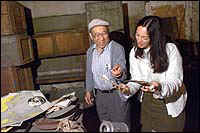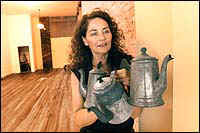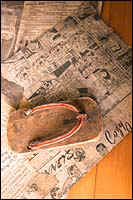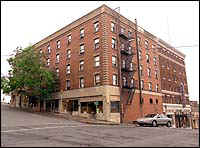|
|
||||||||||||||||
|---|---|---|---|---|---|---|---|---|---|---|---|---|---|---|---|---|
|
|
||||||||||||||||
|
Friday, July 23, 1999 By PHUONG LE
The mystery of the Panama Hotel lies beneath its weathered lobby, at the bottom of 19 creaky wooden steps, beyond a heavy glass door. In a dimly lighted basement, belongings of a generation are frozen in time: kimonos delicately folded in a heavy trunk; worn suitcases adorned with stickers from Yokohama and Kobe; and a 1942 copy of the North American Times newspaper with a blaring headline, "Evacuation of Japanese due within 10 days." It is an accidental time capsule, this dusty basement in Seattle's International District.
In random piles stacked high are household belongings left behind 57 years ago when the United States turned against its own citizens and shipped Japanese Americans to internment camps like Idaho's Minidoka. Forced from their homes in April 1942, a few dozen Seattle families stored their possessions in this cellar, hoping some day to return for them. But many never did, and their electric cookers, gallon-sized cans of Kikkoman soy sauce, homemade tempura baskets and stone drums used for pounding cooked rice into mochi (rice cakes) remained tucked away, out of sight and all but forgotten. Today, the basement recalls a shameful legacy in America's past. Yet it also offers a glimpse back to a time when Seattle's bustling Nihonmachi, or Japantown, was a vibrant commercial hub of fish markets, tailor shops, trading companies, banks and grocery stores. Seattle artist Jan Johnson saw both in the Panama when she bought it in 1986 to save it from being torn down like so many other hotels between Fourth and Seventh avenues. From her artist studio across the street, Johnson had been fascinated with the Panama, a five-story workingman's hotel at 605 1/2 S. Main St. With a tiled bathhouse below the hotel, the Panama attracted thousands of immigrants who came to Seattle at the turn of the century to work in its canneries, saw mills, railroads and farms. "You can see why this hotel became so important to the community," said Marie Rose Wong, an Iowa State University professor in Seattle to do research on hotels like the Panama. "This was the nexus and node."
Johnson sensed it when she descended down the Panama's wooden basement steps and clicked on a bare light bulb. Where some might see clutter, Johnson saw history. She devoted the next decade to preserving the best of it and creating an informal museum to teach schoolchildren. "This is American history," said Johnson, whose own father, son of a Scandinavian immigrant, came to Seattle in the 1930s. "This is what you don't learn in textbooks." Takashi Hori, former owner of the hotel, offered to clear out the basement when he sold it to her in 1986, but Johnson phoned museum curators instead. From out of the clutter came a collection of 37 trunks that went to Los Angeles as part of the "America's Concentration Camps" exhibit, displayed at the Japanese American National Museum. The empty trunks and suitcases, many stenciled with family names and addresses, continue to travel. A smaller exhibit showed at the Ellis Island Immigration Museum earlier this year. Next month, the exhibit opens at the William Breman Jewish Heritage Museum in Atlanta.
What was in the trunks tells a story of families of Japanese ancestry who were also distinctly American: a brocade pillowcase of Mount Rainier National Park, Aqua Velva after shave, a list of graduation requirements from Fife High School's 1938-39 school year, 16 American flags bundled in frayed brown paper and a March 17, 1916, Port of Seattle special-election voters pamphlet. The normalcy was shattered in December 1941 when President Roosevelt signed Executive Order 9066. About 120,000 people of Japanese ancestry were sent to remote internment camps in Idaho, Arizona, California and other states. Two-thirds were U.S. citizens. With just several days notice, Seattle's Japanese community of about 8,000 scrambled to settle their affairs and find storage for their belongings. Some were forced to sell their possessions and property for pennies on the dollar. "Nobody knew what was going to happen to them," remembered 81-year-old Hori, who was imprisoned at Minidoka from 1942 to 1945. "We didn't even know whether we'd come back here or not." Even rumors of the evacuation in 1941 could not prepare families for the horror of what was to come, said David Takami, the local author of a book about Japanese Americans in Seattle. "It was a tumultuous time," he said. "When the order came down it was quite shocking that people would have to leave their homes. They were able to take what they could carry and that wasn't very much." What they did not take with them, they gave away, sold or left with friends or stashed in churches or private basements. Others went to Hori, whose family bought the Panama hotel and building for $20,000 in 1938. "A friend asked me to keep some things," said Hori, a Seward Park resident who ran the Panama with his wife for 45 years. "Word got around that I had storage space. 'Can you store some of my things?' they asked."
Soon his cellar was crammed with wooden model airplane kits and ice skates, mattresses and bed linens and books and newspapers in Japanese and English. Hori returned to Seattle after World War II and reclaimed the hotel from the management company who oversaw it for his family from 1942 to 1945. Hori tried to contact as many families as he could. But many never made it back to this city. Some moved to the suburbs or out of state. Still others didn't want to be reminded of what they lost -- by what they had left behind. "Who needs a broken fishing rod?" said Ed Suguro, a 63-year-old Nisei, or second-generation Japanese, and local community historian. "Later on it didn't mean that much to them. As the years passed, they just forgot about it." Suguro was 6 when his family was incarcerated at Tule Lake, Calif. He recalled how the Panama, like many hotels in Japantown, was "a social gathering place" for male workers and later their families. Designed by Seattle's first Japanese American architect Sabro Ozasa, the Panama was home to itinerant workers who paid about $6 a month for one of 94 single rooms. Today single rooms cost $150 a week. Hori's father was one of them -- an Issei, or first generation Japanese, who worked in a logging camp and brought his wife over in 1906. They ran the hotel and leased out the bathhouse, which had a separate entrance at 302 Fifth Ave. Down in the bathhouse where customers could also get their clothes laundered, original signs on the wall continue to beckon bathers to "take off shoes here" or "please put used towels here." Advertisements promoting local businesses like Yesler Hardware still hang above 15 neatly numbered lockers. Though the peeling ceiling paint is badly in need of repair, the bathhouse maintains its original blue and white floor tiles and linoleum. Steam pipes run along the wall of two saunas made of rough marble. Johnson plans to keep the bathhouse the way it had been when it closed in the 1950s. It is thought to be one of the country's last surviving Japanese bathhouses of that era, Wong said. Johnson plans to change very little about the basement. For the past several years, she has conducted private tours for college students and schoolchildren, hoping that the presence of items allows people to better connect with the meaning of Japanese internment. Later this year, Johnson plans to open the basement to more visitors and add a teahouse. In one of the building's store fronts, the tearoom will hold old photographs of Japantown before the war. Another room would hold exhibits from the Japanese American community. Touring the hotel on a recent morning, the Panama's current owner excitedly pointed out her restoration efforts to the hotel's former owner. Hori nodded at each turn and recalled stories about specific people and memories. He paused before entering the basement and said: "I appreciate her doing it. I wished the Japanese American community had awakened to it sooner."
P-I reporter Phuong Le can be reached at 206-448-8128 or phuongle@seattle-pi.com 605 1/2 South Main Seattle, Washington 98104 Phone: (206) 223-9242 Fax: (206) 624-4957 E-mail: reservations@panamahotelseattle.com |




